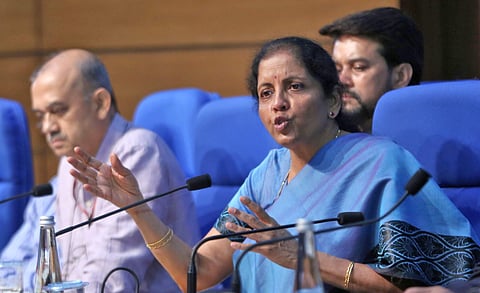

NEW DELHI: Diwali came early for India Inc after the government slashed effective corporate tax to a record low of 25.17 per cent, inclusive of all cess and surcharges, for domestic companies.
What's more, new manufacturing firms, incorporated after October 1 will have to pay even lower effective tax rate of 17.01 per cent provided they start manufacturing by 2023 --- that is, a year before the next general elections.
Analysts say the surprise move is sure to boost the dangling bottom line of companies struggling with a slump in demand, but it may not turn around the business cycle immediately with part of the tax windfall finding its way into savings given the economy is facing aggregate demand shortfall.
While companies in the FMCG, capital goods and steel sectors will see the maximum benefit as many of them have an effective tax rate of over 30 per cent, auto and pharma companies may see lower respite as the effective tax rate is already about 24-25 per cent due to various exemptions the companies avail.
Broadly, the lower rates will improve profit after tax of companies by three per cent to nine per cent depending on their tax bracket.
"The immediate impact of the tax cut would be more on corporate earnings. Since the tax liabilities would come down, corporates would either be able to maintain their profitability or even come out of loss," says Sunil Kumar Sinha, principal economist, India Ratings.
However, the current tax cuts is unlikely to turn around the lean business cycle. Think about it this way: if you’re a CEO and you have difficulty selling your products profitably now, why would lower taxes make you produce more? Even a zero per cent tax rate is no help if you lack customers.
In other words, the tax rate is just one-factor businesses consider when deciding to expand. The far more important question is the consumer's appetite to spend.
“The current constraint on the economy is aggregate demand shortfall, whereas today’s measures amount to supply-side push. As a result, in the near term, part of the tax bounty may find its way into savings instead of being spent (tax-cut multiplier tends to sag during downturns),” explains Kapil Gupta, chief economist, Edelweiss Research.
Take the case of the United States for instance --- President Trump’s tax cuts failed to lift business investment despite a strong business cycle. That apart, private investments are long-term measures and capex revival may still have to wait especially when global headwinds still persist, Gupta adds.
Industry players, too, agree that GST relief perhaps would have delivered higher multiplier as it would have reduced prices and immediately left customers with more disposable income to spend. Mayank Shah, category head at biscuit maker Parle Products, admits that the move will improve profits for companies.
However, he adds, the lower rates “would give some sort of cushion, but it will probably not work the way a rationalisation in GST rate would have worked."